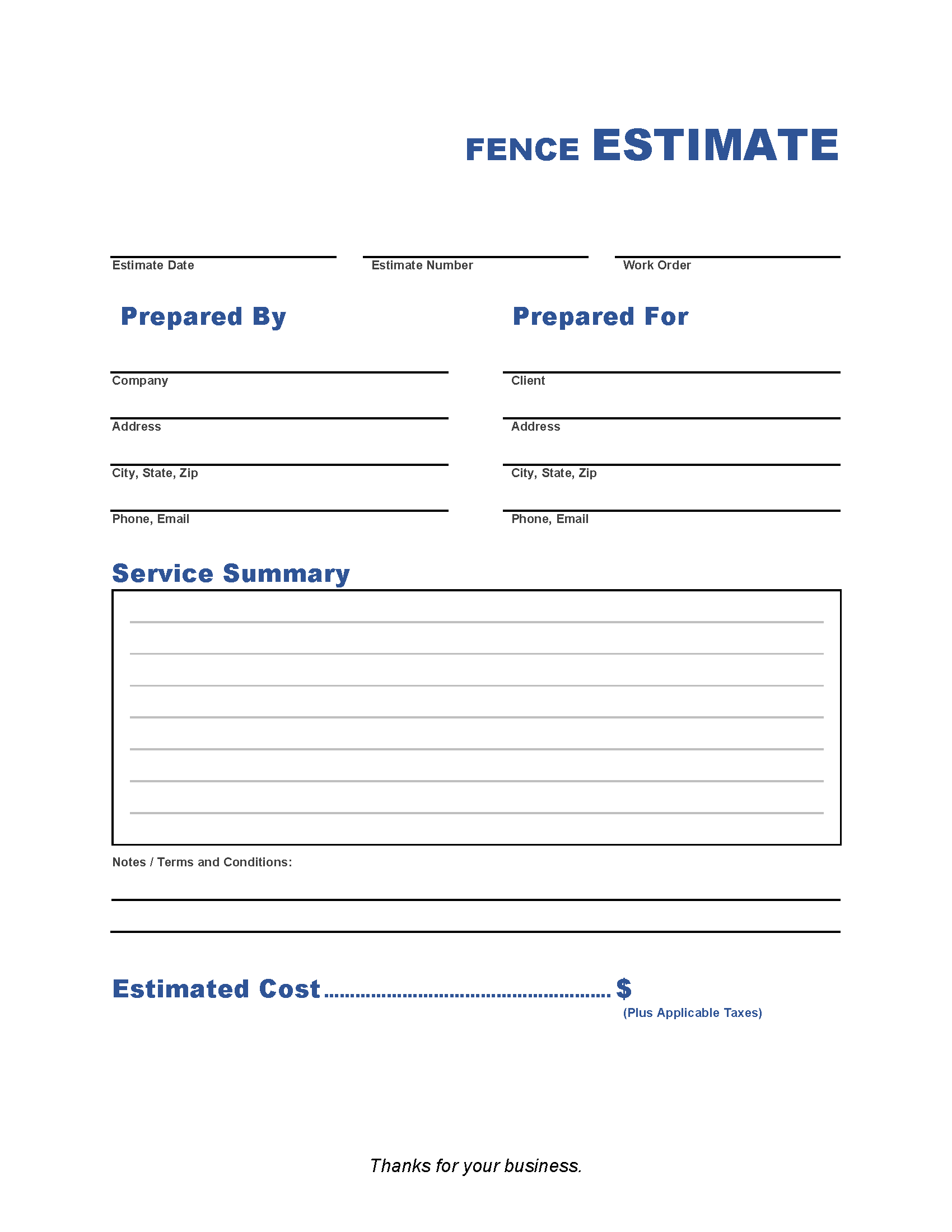Fence Estimate Template
A fence estimate sets out the cost that will be charged for fence installation, replacement, or repair. Broadly speaking, estimates are arrived at by first considering the scope of work, then calculating the anticipated costs to complete that work, and finally, including a reasonable profit margin. Although they need not match the final price charged, fence installers should make every effort to make estimates as accurate as possible.
Information to Include in a Fence Estimate
These areas typically appear as categories in fence estimate documents, but depending on the project others may be required.
Identifying Information
While estimates are typically non-binding documents, they do constitute an agreement of sorts between a client and the person or company working for them. For any estimate, starting with general information and working toward more specific details makes for an intuitive layout. The following are some things that can be included with general information:
- Person or company performing the work and contact info
- Customer or client and contact info
- Location / address where work is to be performed
- Work start and end dates
- Does this estimate have an expiration date?
- Broad description of work (e.g. New fence installation, Existing fence repair, etc.)
Scope of Work
An accurate and clear description of the work to be performed is extremely important. This helps to avoid miscommunication and subsequent disagreement between contractor and client. It will be incredibly difficult to provide an accurate total cost without first understanding the job. Here are some areas that may warrant attention when creating a fence estimate:
- Demolition and hauling of old fence
- Linear feet to be removed
- Approximate location of new fence
- Fence material to be used
- Linear feet to be installed
- Description of gates and gate hardware
- Description of post and concrete work
- Who is responsible for pulling permits?
- Who is responsible for drawing plans?
- Will survey work be subcontracted?
- Will sealing or painting be subcontracted?
Line Items with Associated Costs
Once the scope of work has been established, overall cost can be determined by listing each of the items necessary to complete the job and including their individual costs. Here are some things that might apply to a fence estimate:
- Cost for demo and hauling
- Cost for fence materials and hardware
- Equipment rental cost
- Labor cost
- Cost for survey work
- Cost for plans and permits
- Profit margin
- Total cost
Payment Terms
For smaller jobs that don’t require much capital outlay to start or complete, payment upon completion may suffice. If a job is bigger and it requires significant upfront expenditures for material purchases or labor costs, it may be necessary to require payments in advance or on a specified schedule. Whatever the arrangement, it should be clearly spelled out in the estimate.
Notes
Notes are useful for including information about warrantees, for listing anything that is specifically being excluded from the work, and for identifying anything extraordinary or unusual about the work that should be recorded. Perhaps a customer doesn’t want to remove a tree that is clearly going to affect the fence at some point, for example.
Common Issues for Fence Estimates
The following are issues that may not represent an actual line-item on a fence estimate, but which may play a significant role in the cost of the project and which fence installers should carefully consider.
Property Lines
Be familiar with state and local laws about property lines. When building fences along property lines, it may be prudent to get each property owners’ approval with regard to location and which one gets the “good side” of the fence. If property owners disagree on location of the property line, surveying may be necessary.
Building Codes, Permits, and HOAs
Be familiar with local building codes. Some municipalities have ordinances against building fences over a certain height. Additionally, fences under a certain height may not require permits at all. If the property is in an area that is regulated by an association, type and style of fence may require approval and certain fences may be prohibited entirely.
Know the Fence Material
It makes sense to understand the fencing material before providing a labor cost to install it. Some materials go up rather quickly while others require significantly more labor and time to install. It could be a costly mistake to provide an estimate before the client has chosen a material.
Weather Delays
Will inclement weather cause delays? If significant delays are anticipated, they should be communicated to the customer, and factored into the estimate.
Fluctuating Material Costs and Supply Chain Issues
If the cost of certain materials is fluctuating rapidly or materials are difficult to obtain due to supply chain issues, it may be wise to communicate this to the customer and make note that actual cost of materials will be reported upon purchase and any unexpected delays will be communicated to the customer upon discovery.
How to Use the Fence Estimate Template
To use the fence estimate template, simply download and fill out or use our free estimate generator.
